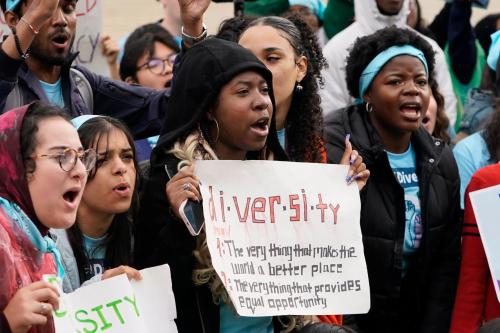The Supreme Court’s decision in Fisher v. University of Texas was largely overlooked, as it was quickly eclipsed by higher-profile decisions involving voting rights and same-sex marriage. However, the Court’s decision to remand to the lower courts clearly signaled their dissatisfaction with the evidence presented to them. If higher education leaders expect to preserve race-conscious admission policies, they will need to assemble much clearer evidence on the feasibility of race-neutral options.
In the Grutter case a decade ago, the University of Michigan and many friends of the court presented evidence on the educational and social value of racial and ethnic diversity on elite college campuses. In the Fisher case, the justices seemed willing to accept the validity of that evidence.
However, the justices were clearly dissatisfied with the evidence on another point: the practicality (or impracticality) of race-neutral means of achieving such diversity. Institutions will need to assemble much clearer evidence on race-neutral options if race-conscious policies are to survive.
When racial diversity is the goal, no race-neutral proxy will work as well as race in producing it. In order to maintain similar amounts of diversity, all proxies for race will impose costs in terms of academic selectivity or some other outcome. (A similar argument is made in Fryer, Loury and Yuret, “An Economic Analysis of Color-Blind Affirmative Action” in the Journal of Law, Economics, and Organization in 2008.) The Fisher decision clearly requires university leaders and courts to document those costs.
The reason for the trade-off is simple: African American and Latino youth are a minority of all young people and, regrettably, a very small minority of the most academically prepared applicants. Even though they are more likely to be low income than whites or Asian Americans, they are a minority of all low-income youth and a smaller minority of low-income, high-scoring youth. For instance, in the National Education Longitudinal Study of the class graduating from high school in 1992, black and Hispanic youth were three times as likely to be from families with incomes less than $20,000 than white and other non-Hispanic youth. However, black and Hispanic youth represented only 7% of the top decile of test-takers. As a result, black and Latino youth represented only one out of six of the low-income youth with test scores in the top decile (17%). Therefore, if family income were to be used as a proxy for race, universities would have to accept and enroll many more low-income students in order to “yield” the same number of minority students.
Here’s one way universities might investigate the trade-offs involved in race-neutral approaches to generating diversity using their own data:
- Ask admission officers to read through each application (or, at least, a random sample of applications) and flag potential race-neutral proxies, such as low-income status or first-generation college student, etc.
- Using the recent admission decisions for white and Asian-American youth, estimate the statistical weight currently being placed on these characteristics, as well as more traditional academic measures such as SAT scores or high school rank. Even if an institution is doing holistic reviews and avoiding simple formulaic answers, it would be useful to know the average weight implicitly being placed on these characteristics when race could be considered explicitly.
- Calculate the average value for each characteristic for African American and Latino youth. Repeat for white and Asian American youth. Also calculate the average acceptance rate under current admission policies of African American and Latino youth as well as for white and Asian American youth.
- Re-estimate the statistical model using the admission decisions for all youth, excluding any direct consideration of race in admission decisions, but imposing the restriction that the acceptance rate of the two groups of youth must be the same as under race-conscious admissions. This approach would find the set of weights on non-racial characteristics which would come closest to reproducing the current decisions on individual candidates, preserving the current acceptance rates by subgroup using race-neutral characteristics.
- The differences in the weights attached to non-racial characteristics when race could be considered explicitly (step 2) and the weights required to produce similar diversity without the use of race (step 4) provide valuable information on the “cost” of race-neutral methods of producing the same amount of racial diversity produced with race-conscious policies.
In the Court’s words, universities must prove that “no workable race-neutral alternatives would produce the educational benefits of diversity.” Unfortunately, the justices left it to their lower court colleagues to define what “workable” means. For instance, would a race-neutral alternative we considered “workable” if it produced more than half as much diversity as a race-conscious policy? (That question could re-open the debate about what constitutes a “critical mass.”) Would a race-neutral policy be considered “workable” if it led to a 100 point decline in the average SAT score of those admitted? (That begs the question of what is the educational value of having higher scoring peers?) How much of an increase in financial aid required to accommodate many more low-income youth would be too much to be “workable”?
Future courts will have to sort out these questions. However, we are much more likely to have a reasonable discussion of these issues based on evidence rather than polemics.




